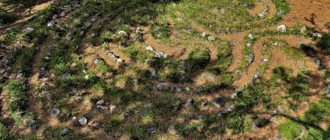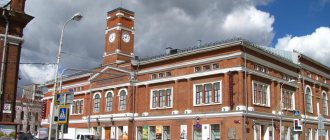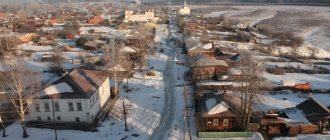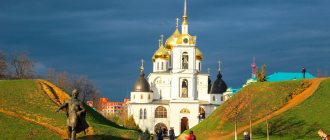Pochep
- a city in Russia, the administrative center of the Pochepsky district of the Bryansk region, within the Klintsov diocese. Located within the Dnieper Lowland, on the Sudost River, 85 km southwest of Bryansk. Railroad station. Population: 17,161 people (2010) [1].
- On the map: Yandex.Map, Google map
There is an assumption that the name of the city is associated with “pochepovshchina” - a type of duty. The name could also come from the word "chep", which means castle in the local dialect. And the border that passed near the city was designated “by the cap.” Popular legend says that there were Tatars here, who burned the fortress and hanged the surviving inhabitants. And the name “Pochep” itself supposedly comes from the verb “cheplyat” - to hang. As evidenced by the research of archaeologists, the Pochepskoe settlement has multi-layered ashes, the city burned out several times. It is difficult to say whether it was always revived under the same name.
In the middle of the 14th century, these lands went to the Grand Duchy of Lithuania. The settlement was first mentioned in 1457 in the Lithuanian Metrics as the settlement “Pochap”, which was granted as a patrimonial possession to Pan Zachary.
Pochep has been known as a fortress city since 1500, among the cities conquered by the troops of Tsar Ivan III from Lithuania.
Since 1571, the fortress was part of the fortified line between Kaluga and Starodub.
In 1610, during the Polish-Lithuanian intervention, about 4 thousand of its defenders died near the walls of Pochep. In 1618 the city went to Poland. In 1686 it was finally annexed to Russia.
Pochep played an important role in Russian trade. It hosted four fairs a year. The richest fair known since 1665, the autumn fair, Ilyinskaya, lasted a whole week.
In 1708, by decree of Peter I, it was re-fortified and became a support base for Russian troops.
In the 18th-19th centuries Pochep belonged to Prince A.D. Menshikov, then - Count K.G. Razumovsky, later - Count K.P. Kleinmichel.
In the “List of populated places according to information from 1859” it is listed as a town of the common class
as part of the Mglinsky district of the Chernigov province. At this time there were 9 Orthodox churches here, and there was a post office and station.
In 1887, the Bryansk-Gomel railway passed through Pochep. Enterprises began to appear around the station, and the construction of private houses began.
Hemp rippers, oil mills, rope factories, chicory factories and hop factories operated here. The production of cloth, paper, and wool products was established. Pochep was famous for its blacksmiths and potters. The existing enterprises were small, handicraft type.
In 1919 it acquired city status. In the pre-war years, a vegetable drying and brick factory and a power plant were built.
On August 21, 1941, the city was occupied by German troops, but the fighting around and in the city itself lasted another 49 days. After two years of occupation, the city was liberated on September 22, 1943.
Since 1944, the city has been part of the Bryansk region. There are canneries, a butter factory, a hemp factory, a starch plant, a meat and poultry plant, and woodworking factories.
Statistics
- 1859 - 677 households, 5285 people (2456 m.p., 2829 zh.p.)
- 1897 - 1358 households, 8424 people
- 2002 - 17064 people (7854 m.p., 9210 zh.p.) [2]
Pochep as you never knew him
The Levitin family from Pochep. Photo: From Pochep with love
In the Russian Empire, from 1791 to 1917, there was the so-called Pale of Settlement - a territory outside of which Jews were prohibited from living. It is worth noting that until the beginning of the 20th century, the population of Russia did not know nationalities: people could only differ in religion. Therefore, it was specifically Jews—persons professing Judaism—that were prohibited from living outside the Pale of Settlement. How did this happen, and why did the Pale of Settlement arise? Initially, the restriction of the territory of residence of Jews was not caused by the desire of the Russian authorities to infringe on their rights. The Russian Empire received a significant number of the Jewish population in 1772 after the first partition of the Polish-Lithuanian Commonwealth (Poland). At this time, its eastern territories were ceded to Russia, whose population was “automatically” assigned to the petty bourgeois and merchant classes. According to the laws of the Russian Empire, townspeople and merchants had to live within the cities and towns to which they were assigned. At the same time, Jewish burghers and Jewish merchants received equal rights with all representatives of these classes in Russia. And with them a ban on freedom of movement.
Subsequently, Jewish merchants tried to overcome this limitation by enrolling in the Moscow and Smolensk merchants. But local merchants saw them as serious competitors and turned to Catherine II with a request to refuse the Jews their petitions. The Empress met the Moscow merchants halfway, allowing Jews to settle only in Belarus, the Ekaterinoslav governorate (now the district of the city of Dnieper, former Dnepropetrovsk) and the Tauride province. In 1791, a decree was issued “On the collection from Jews who have registered in cities as petty bourgeoisie and merchants, the established taxes, which are twice as much as those imposed on the bourgeoisie and merchants of the Christian law of different confessions . It listed all the provinces in which Jews were allowed to reside. Among them were the Novgorod-Seversk and Chernigov provinces , to which Pochep .
Decree of Catherine II of December 23, 1791
The Pale of Settlement included urban-type settlements, which were called shtetls. Jews were also not allowed to live in rural areas. The town differed from the city in that it was smaller in area and had a smaller population. Pochep was one of these places. Jews lived in Pochep even before the establishment of the Pale of Settlement, from the 17th century. A large number of the Jewish population died in 1648 when Khmelnitsky Cossacks attacked the city. In 1882, about 100 Jewish houses were burned. In 1897, the city's Jewish population accounted for ⅓ of the total inhabitants (3,172 out of 9,714). In 1926 the population increased to 3,616 people. Then by 1939 the Jewish population had dropped to 2,314. The life of Jews in Pochep in the 19th and early 20th centuries is described by Beth Galleto in her book “From Pochep with love”.
Beth is the granddaughter of Khana Levitina and Shai Zalman Osherov, who emigrated to America from Pochep. They left in 1911 and settled in Omaha, Nebraska.
Shaya Zalman Osherov and Khana Levitina with their son. Photo: From Pochep with love
Shaya Zalman was born in 1888 in the city of Klimovichi (now Belarus) and then came to Pochep to study as a rabbi. At that time, there was a yeshiva (Jewish religious educational institution) in Pochep. She belonged to the movement of Lubavitcher Hasidism, Chabad. The head of the Pochep yeshiva at that time was Joshua Nathan Gnessin . Rabbi Gnesin sympathized with the movement of Jewish enlightenment, called “Haskala,” which advocated the integration of Jews into Russian society and at the same time for the preservation of the cultural and spiritual values of Judaism. This trend was widespread among Jewish communists at the end of the 19th century. Two boys who studied at the Pochep yeshiva, Uri Nisan Gnesin (the son of a rabbi) and Joseph Chaim Brenner , later became very famous writers, the founders of Hebrew literature.
Joseph Chaim Brenner and Uri Nissan Gnessin. Photo: wikipedia.org
Beth gives a description of Pochep by a resident of that era: “The city was located in a lowland, and it was dirty most of the year. The wooden decks along the houses were mostly rotten and unstable. The passer-by usually tried to get past this slush by jumping and balancing, but still drowned in the mud. And yet, the view of the city was beautiful: a river, the bed of which formed a small lake, the lake was surrounded by a forest that went up a hill at the edge of the city. And the forest itself was a place for romantic dates for young people. The human landscape was a mixture of all possible contradictions. There were Jews and Christians , religious and secular, Zionists and anti-Zionists, socialists and conservatives, Hasidim [literally “pious,” a religious movement in Judaism that emphasizes the emotional comprehension of God] and misnaged [in the Ashkenazi pronunciation of “misnagdim” - “ opponents", ideological opponents of the Hasidim, the movement was widespread in Lithuania], Yiddishists [[adherents of Yiddish] Hebraists [[adherents of Hebrew] However, the atmosphere was tolerant. Even anti-Semitism was not pronounced. There were outrages regarding the Jews, but everyone got along peacefully .”
Pochep, synagogue. Photo: https://pocheplife.wordpress.com
The author also describes the life of Jewish Pochep in the mid-late 19th century using the example of the house of his great-great-grandmother Esther. Esther’s husband, Chaim Levitin, served as a manager for Count Konstantin Petrovich Kleinmichel (the son of the same one that Nekrasov has “Count Pyotr Andreevich Kleinmichel, darling!”). Kleinmichel's estate was located in the suburb of Pochep, Rechitsa. It was a large mansion on a hill, from it there was a road along which trees grew, the road went down to the river. Chaim's wife, Esther, was a midwife in the city. The family lived in a spacious house not far from the estate.
Every Sunday there was a market in Pochep, and sometimes there was a fair. The fair was quite a big event. Many people came to Pochep, and they often needed overnight accommodation. The arriving Jews were distributed to the homes of local co-religionists. Religious Jews who observed the Sabbath (Shabbat) could not work or use transport on Saturday, so they came to the fair the day before, on Friday. Esther, as a righteous woman, was very worried if at 12 noon on Friday they still did not have guests. She asked the younger members of the family to go look for those who had not yet found a place to stay for the night. Guests were sacred on this day. It was considered a great sin if, for some reason, a guest left the hosts’ house on the eve of Shabbat.
Pochep, bazaar. Photo: https://pocheplife.wordpress.com
The family kept a large herd of cows. They didn't sell milk - it was too cheap. But they made cheese, sour cream and butter. On Thursdays, it was all put into barrels, loaded onto a cart and sent to the outskirts of Pochep, where poor Jewish families lived. Russian peasants living on the estate used geese to pay for the use of the land - these geese were also given to Esther, and she distributed them to poor families. For Passover, the family made their own matzah - Lenten flatbreads made from a mixture of flour and water, baked for 18 minutes so that the dough does not have time to ferment. Water for them was taken from a stream. It was often necessary to make an ice hole in it, because... During the Easter period (April) it could still be winter in Pochep.
Chaim had to leave his job with the count after Jews were prohibited from owning land outside the city. Then the count invited him to buy some land on the outskirts of Pochep so that he could have a garden and vegetable garden.
«May you meet a Cossack!” /wishes to an enemy in Yiddish/
The situation of Jews in Pochep once again worsened on the eve of the first Russian revolution of 1905-1907. Driven to despair by lack of rights and poverty, Jewish youth actively took part in the revolutionary movement. The Jewish socialist parties Poalei Zion and the Bund operated in Pochep. Their main demands were the elimination of the Pale of Settlement and the provision of civil equality to Jews.
Thus, the book “From Pochep with Love” describes the mood that reigned in the city at that time: “In order to prepare for possible trouble, residents began to create self-defense units in our city: just like in other cities.
Pochep was a city with a mixed population, of about ten thousand inhabitants, a third were Jews. There was no separate Jewish district; all neighborhoods were mixed. The roofs were thatched or wooden, and it was clear that if there was a fire, it would spread from house to house. It was an agreement in our community that if riots broke out, every Jew would set his home on fire, and the homes of non-Jews would also be damaged. This circumstance was known to all residents of the city and was a deterrent for them. A small empty building in a garden […]on the outskirts of the city became our meeting place. [[...]we had 12 pistols. We were afraid that this fact would become known because there were spies and informants around. [[...]the authorities knew that revolutionaries were operating in Pochep, so a battalion of 2,000 Cossacks was sent to the city to ensure order. Fully armed, the Cossacks rode horseback through the streets of the city, and were also quartered here. Three people were caught and hanged. The Jewish youth self-defense units were afraid that their weapons would be found, and this would have consequences.” Di shvue , anthem of the Bund party.
One of the most famous songs of the Jewish labor movement, the grandmother of the book’s author, also recalls the following incident: “Another incident occurred during one of the annual Pochep fairs. The rioters, shouting anti-Jewish slogans, began to loot the street where the shops of poor Jews were located. The policeman stood on the street in front of the house, calmly looked at it and did not interfere with the riots. Suddenly, a youth from the self-defense unit slipped behind him, hit the officer on the head with brass knuckles and disappeared. The officer fell dead, the crowd got scared and fled. At that time I was alone in our big house on the outskirts. Mom and Dad had gone somewhere, the boys were in the self-defense unit, and the youngest were at school. It was approximately ten o'clock in the morning. I saw carts rushing away from the city, heard screams and panic. The men shouted to each other “Run, faster!” I didn't understand what was happening. I thought: “So the pogroms have begun.” I was alone. I did not have a gun, but I was given a bottle of sulfuric acid for self-defense in case of attack. I thought: “How stupid! If a Cossack comes in, will he do it so slowly that I can have time to splash liquid in his face?” I decided to hide in the cellar. After a while the noise died down. Family members returned home detailing what happened and what they saw. First of all, no one knew who killed the policeman. But little by little the rumor began to spread. This was one of the sons of a butcher from Pochep, the leader of a self-defense unit. He disappeared. It was only two years later that he was suddenly encountered while hiding.”
The pogroms that the author's grandmother recalls were part of the second of three waves of pogroms that swept across Russia, each more brutal and destructive than the last. The first, in the 1880s, followed the assassination of Tsar Alexander II. At that time, the government tightened laws regarding Jews. The May decrees of 1882 limited their admission to institutions of higher education. The second wave of pogroms occurred between 1903 and 1906. The third - after the Russian revolution of 1917 and lasted until 1921. Pogroms occurred in 64 cities and 626 towns, including the city of Pochep. The number of those killed was in the hundreds.
Due to constant fear and brutal pogroms, as well as suffering from a worsening economic situation, Jews began to leave Russia in large numbers. So the grandmother of the author of the book “From Pochep with Love,” Khana Levitina, left the country forever.
After the 1917 revolution, the city still had a significant Jewish population. In August 1941, when Wehrmacht troops occupied Pochep, two camps for Jews were created in the city. The men were kept behind the school. Kalinina, near the swamp. Women - on the territory of the former Poultry Plant. In March 1942 they were all shot, 1846 people were killed. Only one girl survived, Sonya Makhlina. The Russian nanny Tatyana Nedostoyeva saved her and passed her off as her daughter. The woman’s feat is immortalized at the Yad Vashem Holocaust Memorial Complex in Jerusalem. The complex is located high above the city, on Mount Herzl. Tatiana's name can be found on a stele under a carriage from Auschwitz. It soars high above Jerusalem and the whole world.
Memorial Yad Vashem, stele with the name of Tatyana Nedostoyeva
In the next article you can watch a video of a whole country singing a song from Pochep: Shmuel Bas - writer and teacher
Author of the article: Ekaterina Zhilina
The materials on this resource are intended for informational viewing only. The rights to any materials presented on the site belong to their legal owners. When using photo and video materials from the site, a link to vialky.ru is required.
Cathedral of the Resurrection
In the mid-18th century, by decree of Count Razumovsky, the development of the city of Pochep began. By his decree, the beautiful Cathedral of the Resurrection was erected, the design of which was developed by the popular Italian architect Antonio Rinaldi.
The cathedral is the only building that has survived from the estate. Today it is the hallmark of the city, which many tourists seek to see. The design of the temple traces the Baroque and classicism styles and consists of two floors.
At first glance, the cathedral does not look like a simple provincial building; it could become the main attraction of the capital. The interior is richly furnished: stained glass windows, gilded parts of the iconostasis.
The iconostasis was made according to a sketch by Rastrelli and is a unique work. The icons in the temple are the best works of the artist Stetsenko.
Location: Oktyabrskaya Square - 10.
Fortress "Vali"
It was erected in the autumn of 1708 by order of Peter I during preparations for the war with Sweden in the north of the city, and is a monument to military engineering. The fortress was built from the ground in the shape of an irregular pentagon and was in full combat readiness. Today, the contours of the fortress have been preserved, which the townspeople call “ramps”; their length reached 1.5 km.
Museum of Local Lore
The museum collection contains 4 thousand objects and more than 3 thousand exhibitions. Interesting materials include archaeological finds, household items from the 19th century, documentation about the lives of the Razumovskys, Zhemchugovs and Menshikovs. More modern topics are things and weapons from the Great Patriotic War.
Works on the animal and plant world of the Bryansk region are presented. 10 researchers are working on the preservation and development of the museum.
Location: Oktyabrsky passage - 1.
Church of the Intercession of the Blessed Virgin Mary
The temple is located in the Lyubimovka estate. Built around 1840 by landowner Yu. A. Krekshina. After the 1930s, the church ceased to exist; it housed a store and then a hostel. But the church was soon restored and operates today, with a children's Sunday school. Divine services are held 3 times a week.
Location: Pionerskaya street - 6B.
Church of St. Nicholas the Wonderworker
The church was built in 1860. It is located in a village formerly called Staropochepye, located on the banks of the Kosta River. The building is made in a complex style, some parts of the room have different heights, which makes the structure more unique. Paintings, icons from the 19th century and a gilded iconostasis of that time have been preserved on the walls.
Park "Upper Garden"
The park recalls the magnificent life of Menshikov, according to whose plan it was carried out. Later the park was expanded at the direction of Razumovsky. Located in the north-west of Pochep. In ancient times, the unusual beauty of the park was framed by an artificial lake, which originated from the Namige stream with a water mill. Now the park has straight alleys, reminiscent of the former beauty and geometric plant pattern of the garden. The real attraction of the park is the huge linden trees, which are more than 200 years old.
Memorial Museum of A.K. Tolstoy
Not far from Bryansk is the village of Krasny Rog. The Russian poet Alexei Tolstoy lived there for many years. The manor was built in the Baroque style in the mid-18th century. The museum presents an exhibition dedicated to the life of the playwright and his relatives, the Zhemchuzhnikovs. The museum's collection provides Tolstoy's household items, furniture, books, portraits of family and friends for viewing. On the territory of the estate there is a park in which buildings from the time of the poet have been preserved: a gatehouse, a poultry house, a cellar.
Avenue of Heroes
Alleys of Heroes have begun to open in many cities in our country. It was opened in Pochep on September 22, 2000. There are monuments to heroes of the USSR and busts of holders of the Order of Glory in three degrees. On the alley there is a capsule for descendants with an appeal, the contents of which tell about the life of the area. The capsule is due to open in 2023.











